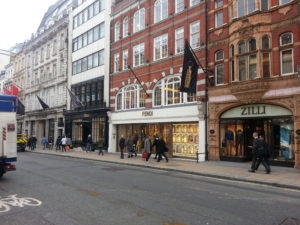
Fendi, Bond Street- Mallett displaced
So goes the headline in a recent issue of the Antiques Trade Gazette, touting an upcoming trade conference in London featuring, so the article goes, experts on the marketing of luxury goods from whom, presumably, the ailing antiques trade might take a lesson.
Frankly, I don’t know that the trade, composed entirely of smallish, independent businesses have much to learn from what is now the international trade in luxury goods, overarched by LVMH, the behemoth whose marques include Chanel, Fendi, and innumerable others besides the Louis Vuitton and Moet Hennesy brands from which initials the company derives its name. How on earth the trade can compete in promotion with the capital brought to bear by a company such as this, I do not know. Witness my earlier blog posts, Bond Street has become a thoroughfare almost entirely devoted to the retail outlets for the various LMVH brands, with the venerable storefront occupied for so many decades by Mallett for some years now taken over by Fendi.
Moreover, I would question the underlying premise, that the trade might wish to ape luxury goods marketing as this assumes competition for the money spent on what it is the trade has to offer comes entirely from the same pool of buyers. I have for a long time considered that my competition comes from all online retailers who sell furniture and decorative objects, whether period or not. The so-called big box stores and online platforms selling looks-like- but-isn’t non-period and vintage items siphon very much of what formerly went to dealers. The accredited trade also has had much of its business spirited away by the auction houses who now see themselves very much as retail vendors in the business of antiques and fine art. The major houses, in particular, are keenly aware of the benefit of online trading, with Christie’s and Sotheby’s offering commission free buying in their online auctions.
So what to do? It might be thought that dealer organizations might band their members together for purposes of cooperatively promoting the trade. Good luck in doing that- cumulatively, I doubt that every member of the accredited trade could even with the most generous whip around accumulate an annual budget for promotion that would match what Chanel spends in a week. And promotion in what manner and to what effect? Print media? Media ads are hugely cheaper than they were a few years ago, but one needs only to see that very many of the connoiseurial and shelter publications in which ads might be placed have a size of book that is now hugely less, reflecting an ever-growing disinterest in print.
No answers or suggestions in this post, I’m afraid to say, with Chappell & McCullar not a stranger amongst the dealers casting about trying to stay in front of new and prospective clients. While certainly time tested methods can hardly be relied upon to be effective, the imitation of other luxury goods merchants offers no real way forward either. Sadly, the trade in art and antiques counts these days as an ornamental small fish under threat from much bigger fish in a large, international retail pond.
